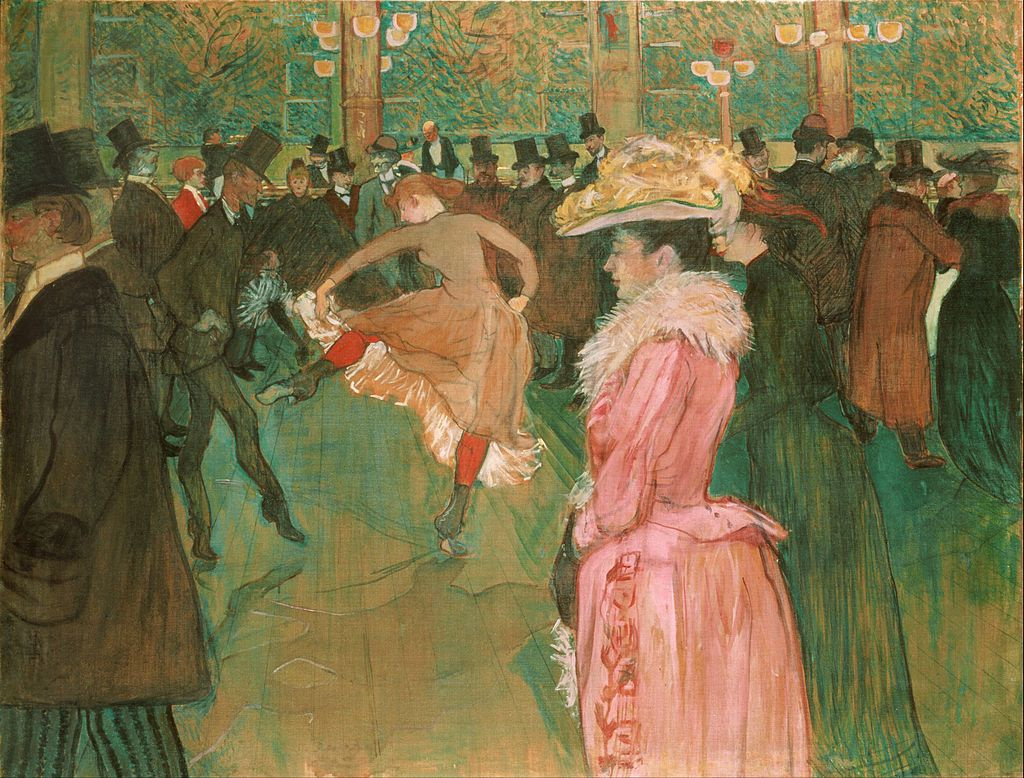log in
Enter site
Login to use Arthive functionality to the maximum
At the Moulin Rouge: the dance
Henri de Toulouse-Lautrec • Painting, 1890, 115.6×149.9 cm
Description of the artwork «At the Moulin Rouge: the dance»
The Moulin Rouge dance hall opened on October 5, 1889, and became a meeting place for Parisian society, artists, and the semi-celebrities. Above the entrance was a life-size red mill, which gave the club its name. Inside there were many cubicles and booths, as well as a large wooden elephant which transformed into a stage. The main hall was lit like daylight and decorated with mirrors, galleries, and gas lanterns. In the center was a large dance floor surrounded by a walkway, tables, and a garden. From day one, a table was reserved for Toulouse-Lautrec, and his sketches and paintings were a kind of chronicle of the establishment. They became a significant component of the Moulin Rouge's fame and were occasionally exhibited in the foyer.
Canvas "Moulin Rouge: The Dance." - one of the most ambitious and ambitious of his career, Toulouse-Lautrec began painting shortly after opening the cabaret. The inscription on the back, probably by himself, reads: "Valentin Beskostny teaches new girls. Under this pseudonym, Jules Etienne Edm Renodin, a wine merchant, performed at the Moulin Rouge. He earned his nickname from Ehlers-Danlos syndrome, which allowed him to move, bend and deform his body as if it had no bones. His partner pulls up her leg and skirts, showing off her red stockings.
They perform le chahut (le chayou) or cancan is an energetic and frank dance that was considered obscene for its time. Today it seems to be comparable to twerking in high-cut shorts. Lautrec probably portrayed a pause between performances as visitors stroll around, chatting and having a drink. Many of the characters in the background are recognizable. Among them is the gray-bearded Irish poet William Butler Yates, leaning against the bar, and even Toulouse-Lautrec's own father.
The identity of the woman in pink standing in the foreground, however, remains a mystery. The beauty of her face is particularly underscored by the companion's profile, which is almost devoid of chin. It is this character, better than any of the others in this company, that demonstrates Lautrec's ability to be brutally truthful, but also truly kind in his observations.
Charles Sidler and Joseph Oller, co-founders of the Moulin Rouge, liked the painting so much that they hung it in the main hall above the bar. There it remained at least until 1893, and then changed several owners. In 1934, the painting was bought by American collector and philanthropist Henry Plumer McIlhenny, who gave it to the Philadelphia Museum of Art. There it remains to this day.
Author: Vlad Maslov
Canvas "Moulin Rouge: The Dance." - one of the most ambitious and ambitious of his career, Toulouse-Lautrec began painting shortly after opening the cabaret. The inscription on the back, probably by himself, reads: "Valentin Beskostny teaches new girls. Under this pseudonym, Jules Etienne Edm Renodin, a wine merchant, performed at the Moulin Rouge. He earned his nickname from Ehlers-Danlos syndrome, which allowed him to move, bend and deform his body as if it had no bones. His partner pulls up her leg and skirts, showing off her red stockings.
They perform le chahut (le chayou) or cancan is an energetic and frank dance that was considered obscene for its time. Today it seems to be comparable to twerking in high-cut shorts. Lautrec probably portrayed a pause between performances as visitors stroll around, chatting and having a drink. Many of the characters in the background are recognizable. Among them is the gray-bearded Irish poet William Butler Yates, leaning against the bar, and even Toulouse-Lautrec's own father.
The identity of the woman in pink standing in the foreground, however, remains a mystery. The beauty of her face is particularly underscored by the companion's profile, which is almost devoid of chin. It is this character, better than any of the others in this company, that demonstrates Lautrec's ability to be brutally truthful, but also truly kind in his observations.
Charles Sidler and Joseph Oller, co-founders of the Moulin Rouge, liked the painting so much that they hung it in the main hall above the bar. There it remained at least until 1893, and then changed several owners. In 1934, the painting was bought by American collector and philanthropist Henry Plumer McIlhenny, who gave it to the Philadelphia Museum of Art. There it remains to this day.
Author: Vlad Maslov


